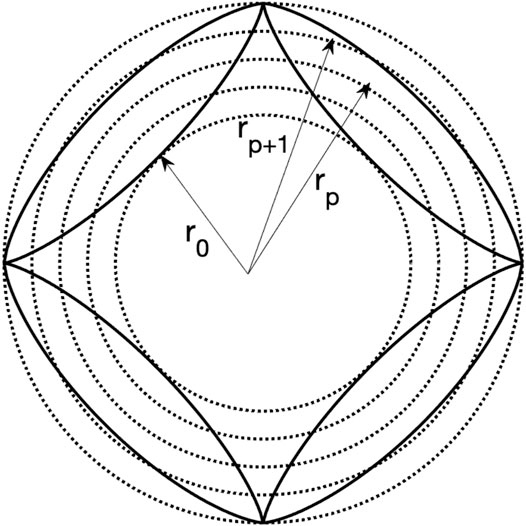Computation of Optical Properties of Core-Shell Super-Spheroids Using a GPU Implementation of the Invariant Imbedding T-Matrix Method
- 1Key Laboratory of Geoscience Big Data and Deep Resources of Zhejiang Province, School of Earth Sciences, Zhejiang University, Hangzhou, China
- 2Center for Earth System Modeling and Prediction, China Meteorological Administration, Beijing, China
- 3Key Laboratory of Atmospheric Chemistry of CMA, Institute of Atmospheric Composition, Chinese Academy of Meteorological Sciences, Beijing, China
Particles with internal inclusions or cores are ubiquitous in the atmosphere. One example is dust particles coated with water-soluble aerosols such as sulfate or nitrate. For these particles, the dust non-sphericity and the core-shell structure of the particle both fundamentally impact the optical properties. However, it is challenging to obtain an accurate and comprehensive parameterization of the optical properties of coated atmospheric particles. Recent studies have found that super-spheroids could provide a robust model for representing the non-sphericity of irregular particles, such as dust, sea salt, and ice particles. This important finding warrants further investigations on coated super-spheroids for the development of mixed-aerosol models. In this study, we developed a GPU version of the invariant imbedding T-matrix program (GPU-IITM) to improve the computational efficiency. This version allows for efficient computation of the optical properties of coated super-spheroids with extensive shape parameters and refractive indices. The GPU-IITM is 8–25 times more efficient than the conventional CPU-IITM, depending on the size parameter of the coated super-spheroids. The single-scattering properties of coated super-spheroids computed from the GPU-IITM allows for close examination of the optical differences between homogeneous and inhomogeneous particles. As an example, we present the linear depolarization ratios (LDRs) of coated super-spheroids, which have implications in active lidar remote-sensing research. We found that the LDR decreases obviously as the real part of the shell’s refractive index increases from 1.3 to 1.6. Greater LDRs occur for particles with a thin coating, while a rounder shape of the particle decreases the LDRs. However, special attention should be given to nearly spherical particles, for which the LDRs could be enhanced. In comparison to homogeneous particles, the degree of enhancement decreases or increases depending on whether the shell’s refractive index is smaller or larger than the core refractive index.
Introduction
Studies on atmospheric radiative transfer and remote sensing fundamentally require accurate knowledge of the optical properties of various aerosol particles (Dubovik et al., 2006; Dubovik et al., 2019; Xu, et al., 2021). However, due to the complexity of particle shapes and mixing states, it has been extremely challenging to develop a universal approach to modelling atmospheric particles. Substantial progress has been achieved in understanding the impact of particle non-sphericity and inhomogeneity on the optical properties by using a number of idealized geometries or “realistic” replicas of microscopic images of particles. Kahnert et al. (2014) and Yang et al. (2018) reviewed research efforts in developing non-spherical aerosol and ice models, respectively.
Regarding the mixing state of multiple aerosol components, the particle mixtures in the atmosphere can be appropriately classified as external, semi-external, and internal mixtures (Mishchenko et al., 2004). Based on a two-component model, the optical properties of semi-external and external mixtures have been found to be similar with relatively small differences. However, the optical properties of internal mixtures (one or multiple aerosol components imbedded in a large host particle) could be significantly different from those of external mixtures. An internally mixed aerosol optics scheme is important in remote sensing studies and is fundamentally required in general circulation models, and the weather research and forecasting models for quantifying the impact of aerosols on the planetary boundary layer (e.g., Bauer et al., 2007; Wang et al., 2015; Chen et al., 2021; Wang et al., 2022).
Internal mixing scenarios are ubiquitous in the atmosphere and are primarily associated with the coagulation and coalescence of particles, or the condensation of gas precursors on aerosol surfaces with possible heterogeneous reactions (Tomasi et al., 2017). One important example is dust particles mixed with other types of aerosols. When dust aerosols are transported in the atmosphere, it is quite common to see dust particles mixed with air pollutants such as black carbon, organic carbon, sulfate and nitrate. Dust particles and water-soluble aerosols normally form a core-shell structure. Li and Shao (2009) collected aerosol samples during episodes of brown haze and dust in Beijing, China. The transmission electron microcopy (TEM) coupled with energy-dispersive X-ray microanalysis was used to analyze 332 mineral dust particles, and it was found that ∼90% of dust particles were covered with nitrate coatings. Based on an analysis of 8,441 particles sampled in Northern Europe and Western Africa, Unga et al. (2018) found that 60% of urban and 20% of desert dust particles presented residuals of coatings. Recently, Wang et al. (2021) reported that internally mixed particles are more common during haze days than non-haze days. For these internally mixed particles, both the particle non-sphericity and the core-shell structure should be carefully examined to quantify their impact on the optical properties (Bauer et al., 2007; Zhang et al., 2020; Zhang et al., 2022).
There have been various advancements in relevant computational techniques, such as the T-matrix method (Mishchenko et al., 2002; Mackowski and Mishchenko, 1996; Bi and Yang, 2014), the discrete dipole approximation method (Purcell and Pennypacker, 1973; Draine, 1988; Yurkin and Hoekstra, 2007), and the finite-difference/pseudo-spectral time domain method (Yang and Liou, 1996; Liu et al., 2012). These techniques make it easier to perform case studies with a few shape parameters and refractive indices in constrained ranges of the shape and size parameters. However, it is still challenging to perform extensive simulations of optical properties even for a well-defined simple model, particularly when the size parameter is large.
To facilitate applications related to atmospheric radiative transfer and remote sensing studies, continual research efforts are required to comprehensively examine the optical properties of particles in terms of the variation of shape and size parameters and the refractive indices. For example, in a previous study, we systematically examined the optical properties of non-spherical particles in a super-spheroidal shape space (Bi et al., 2018a). Later, a super-spheroidal model was applied to model the optical properties of dust aerosols, sea salts, and ice crystals (Bi et al., 2018b; Lin et al., 2018; Sun et al., 2021; Li et al., 2022). We believe that the advantages of the super-spheroidal model in remote sensing and climate research warrant further investigations of coated super-spheroids for the study of the optical properties of internally mixed aerosol models.
In this study, we implemented a coated super-spheroid model in the invariant imbedding T-matrix program (IITM) to compute the optical properties. The IITM is appliable to arbitrarily shaped and inhomogeneous particles. The original IITM code developed by Bi et al. (2013a, 2013b), Bi and Yang (2014), and Bi et al. (2018a, 2018b) was built upon the OpenMP architecture with central-processing-unit (CPU) threading. To improve the computational efficiency of the IITM, we developed an implementation of it on a graphics processing unit (GPU) called GPU-IITM. GPUs have advantages in parallel processing due to their massive computation cores. GPU acceleration has been applied in light-scattering research to improve the computational efficiency (e.g., Huntemann et al., 2011; Iadarola et al., 2012; Egel et al., 2017).
The remainder of this paper is organized as follows. In Section 2, we describe the coated super-spheroidal model and computational parameters for the optical property calculation. The IITM algorithm and the GPU implementation are briefly introduced, and a test of the performance of GPU-IITM is presented with numerical examples. Computational results of coated super-spheroids are given in Section 3. We focused on the backscattering linear depolarization ratio (LDR), which is an important quantity that is relevant to light detection and ranging (lidar) observations of aerosol mixtures. We examined the LDRs of coated super-spheroids with respect to the refractive index of the coating layer and comprehensively investigated how the aspect ratio and the roundness parameters of the particles impact the LDRs. In particular, we compared the optical properties of coated super-spheroids and homogeneous super-spheroids and discussed relevant implications in lidar remote sensing.
Methods
Coated Super-Spheroidal Model
The super-spheroid equation in a Cartesian coordinate system is (Barr, 1981):
where a and c are the horizontal and vertical semi-axes, respectively, and
Figure 1 shows a few examples illustrating the geometry of coated super-spheroids. The roundness parameter of the internal core (
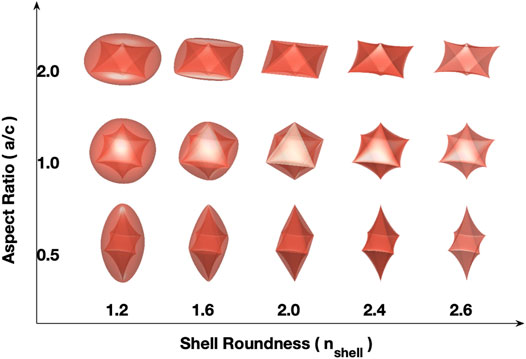
FIGURE 1. Examples of coated super-spheroids. The roundness of core is fixed at 2.6 and 11 aspect ratios ranging from 0.5 to 2.0 and nine shell roundness parameters ranging from 1.0 to 2.6 are considered in the GPU-IITM simulations.
In defining the coated super-spheroid, we assume that the semi-major axes of the shell and the core are identical. For close examination of the optical property variation with respect to particle shapes, we considered 11 aspect ratios ranging from 0.5 to 2.0, as well as nine shell roundness parameters ranging from 1.0 to 2.6. The reason is that coated dust particles have no particular shape and could be diverse.
When the shell roundness parameter is identical to the core roundness parameter (2.6), the particles are basically an internal core without a coating—that is, homogeneous super-spheroids. When the shell roundness parameter is 1.0, the particle is an inhomogeneous sphere (
The real part of the complex refractive index of dust particles ranges from 1.4 to 1.6, whereas the imaginary part is on the order 10−3 at short wavelengths (e.g., Di Biagio et al., 2019; Zong et al., 2021). Therefore, we considered three real parts (1.4, 1.5, and 1.6) and four imaginary parts (5 × 10−4, 0.001, 0.005, and 0.01) to resolve potential uncertainties. For the shell part, we considered four real parts (1.3, 1.4, 1.5, and 1.6) and seven imaginary parts (10−7, 10−5, 10−4, 0.001, 0.005, 0.01, 0.05), which allow us to study different shell compositions, including water-soluble aerosols such as sulfate, nitrate, and sea salt aerosols.
The refractive index of water-soluble aerosols depends on the ambient relative humidity, so it usually varies between 1.33 and 1.55. According to Mishchenko et al. (2016), sulfate’s refractive indices at a relative humidity of 50% are 1.3813, 1.3684, and 1.3595 at 355, 532, and 1,064 nm, respectively. These values are little bit smaller than those reported by Bauer et al. (2007). The real part of the complex refractive index in a wavelength range of 300–2000 nm is between 1.3685 and 1.4247 for sulfate and between 1.3745 and 1.4205 for nitrate at 75% relative humidity. In this study, all numerical simulations were carried out at anchor points instead of refractive indices at specific wavelengths and relative humidity. The complex refractive indices involved in the GPU-IITM simulations are given in Table 1. In the following, the shell and core refractive indices are denoted as

TABLE 1. The refractive indices used in the GPU-IITM simulations. The shell and core refractive indices are denoted as
The IITM and Graphics Processing Unit Implementation
Consider the electromagnetic wave scattering by a macroscopic particle in a non-absorbing medium. The incident and scattered electric fields in terms of suitable vector spherical wave functions can be expanded as follows (Mishchenko, et al., 2002):
Thus, the T-matrix
In Eqs 2, 3,
In the IITM method, coated super-spheroids are discretized into multiple spherical layers. The invariant imbedding equation to compute the T-matrix is (Bi and Yang, 2014):
where
All
To implement the IITM algorithm based on a GPU, we used the OpenACC and Compute Unified Device Architecture (CUDA) libraries. The OpenACC directives were added to the IITM code in a similar way to the use of OpenMP. Matrix multiplication and division were accelerated by the CUDA libraries. Large matrix multiplication was implemented using the cuBLAS library, and matrix division was implemented using the cuSOLVER library. The procedure of the GPU acceleration is illustrated in Figure 3. Four sub-matrices of the T-matrix are calculated separately in parallel. With each process by the MPI, one GPU is linked with the process to calculate one sub-T-matrix. For each new layer, the algorithm starts the calculation of the U-matrix, which is the only part that is dependent on the shape and refractive index.
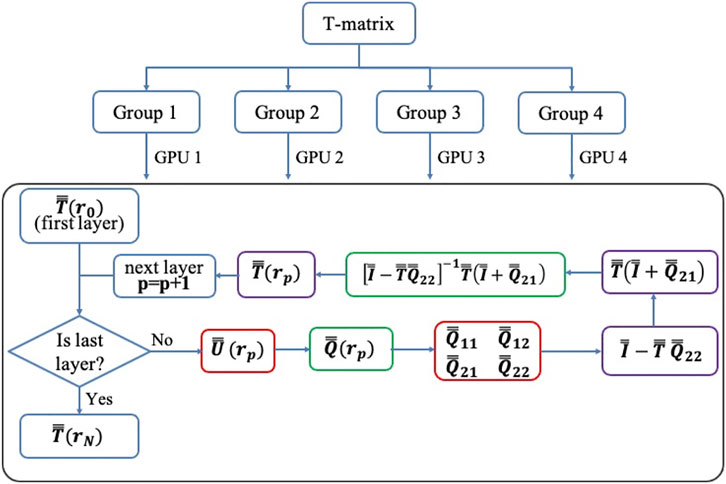
FIGURE 3. A flowchart of the GPU-IITM in calculating the T-matrix. The colored boxes means that GPU acceleration was used. The red boxes use OpenACC, and the green boxes use cuSOLVER for matrix division, and the purple boxes use cuBLAS for matrix multiplication.
The performance of the GPU-IITM was compared with that of the CPU version. For the numerical test, 24 Intel Xeon E5 CPUs were used, while two NVIDIA Tesla K80 accelerators were used for the GPU code. One Tesla K80 card contains two GPUs. The computational parameters of coated super-spheroids are
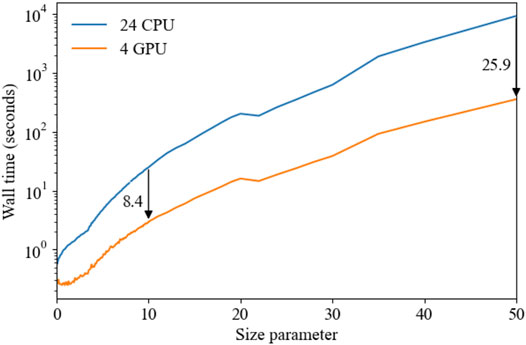
FIGURE 4. A comparison of the computational wall-clock time used for computing the optical properties of coated super-spheroid by using GPUs and CPUs. The wall-clock time ratios (the CPU time divided by the GPU time) are 8.4 and 25.9 at two chosen size parameters of 10 and 50 (indicated with arrows), respectively.
All the optical properties are computed from the T-matrix. However, in this study, we focus on analyzing the LDRs of coated super-spheroids. LDRs with direct backscattering are computed from the elements
For randomly oriented particles,
Results and Discussion
We first look at the impact of the refractive index on the LDRs. For simplicity, let the core refractive index be
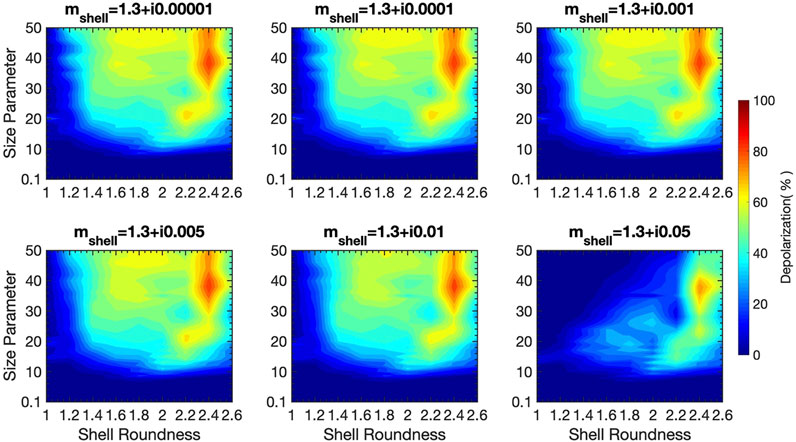
FIGURE 5. Linear depolarization ratios as function of size parameter and shell roundness. The core roundness is fixed to 2.6, and the aspect ratio is 1.0. The core refractive index is 1.5 + i0.005.
Five imaginary parts of the shell’s refractive index (10−5, 10−4, 10−3,0.005, and 0.01) were found to have similar impacts on the LDRs, although differences are expected to be large when the size parameter is sufficiently large (beyond 50 in the present study). Of particular interest is that coated super-spheroids at all refractive indices have higher LDRs when the shell roundness is ∼2.4, with which the particle has a thin coating (the particles are homogeneous super-spheroids at
Next, the imaginary part of the shell’s refractive index,
Next, we examined the impact of the particles’ aspect ratio on the LDRs. Figure 6 shows the results of coated super-spheroids with 11 aspect ratios. The refractive indices of the core and shell are 1.5 + i0.005 and 1.3 + i0.00001, respectively. For each aspect ratio, we examined the dependence of LDRs on the shell roundness parameter and the size parameter. Of most interest is that LDRs are higher around the shell roundness (
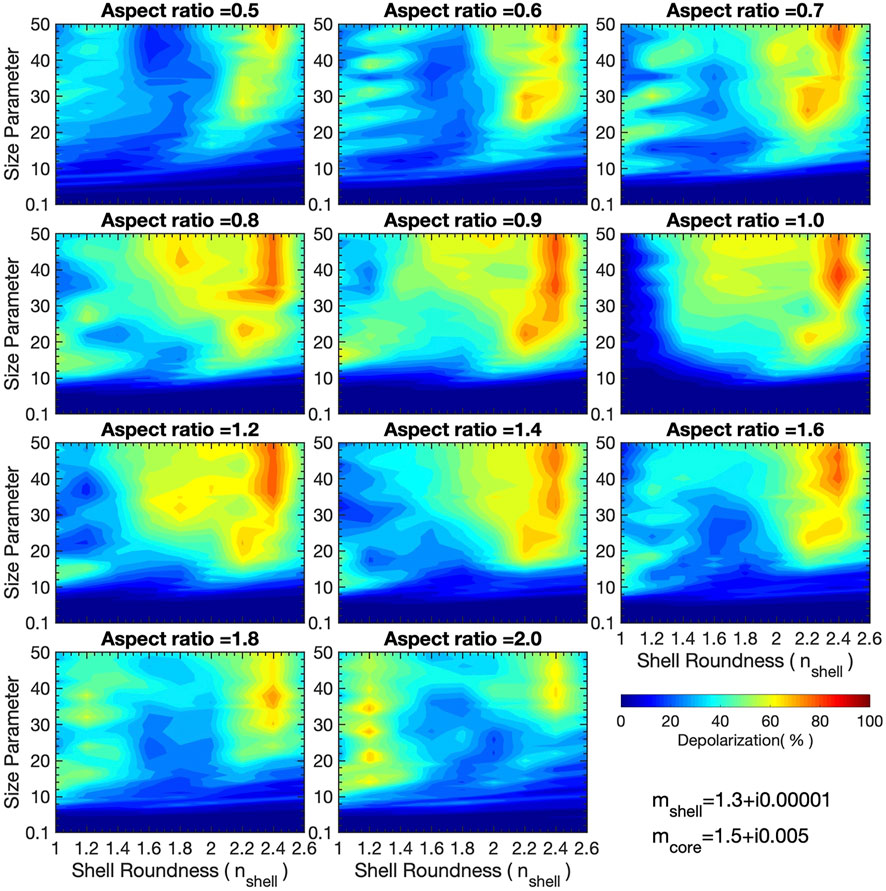
FIGURE 6. Linear depolarization ratios of coated super-spheroids with 11 aspect ratios (0.5–2.0) and nine shell roundness parameters (from 1.0 to 2.6). The core roundness is fixed at 2.6. The size parameter ranges from 0.1 to 50. The refractive indices of the core and shell are 1.5 + i0.005 and 1.3 + i0.00001, respectively.
Figures 7–9 are similar to Figure 6 except that the real parts of the shells’ refractive indices are different. When the shell’s refractive index is 1.4 + i0.00001, the results are similar to those at 1.3 + i0.00001 but with the decreased LDR values. LDRs further decrease when
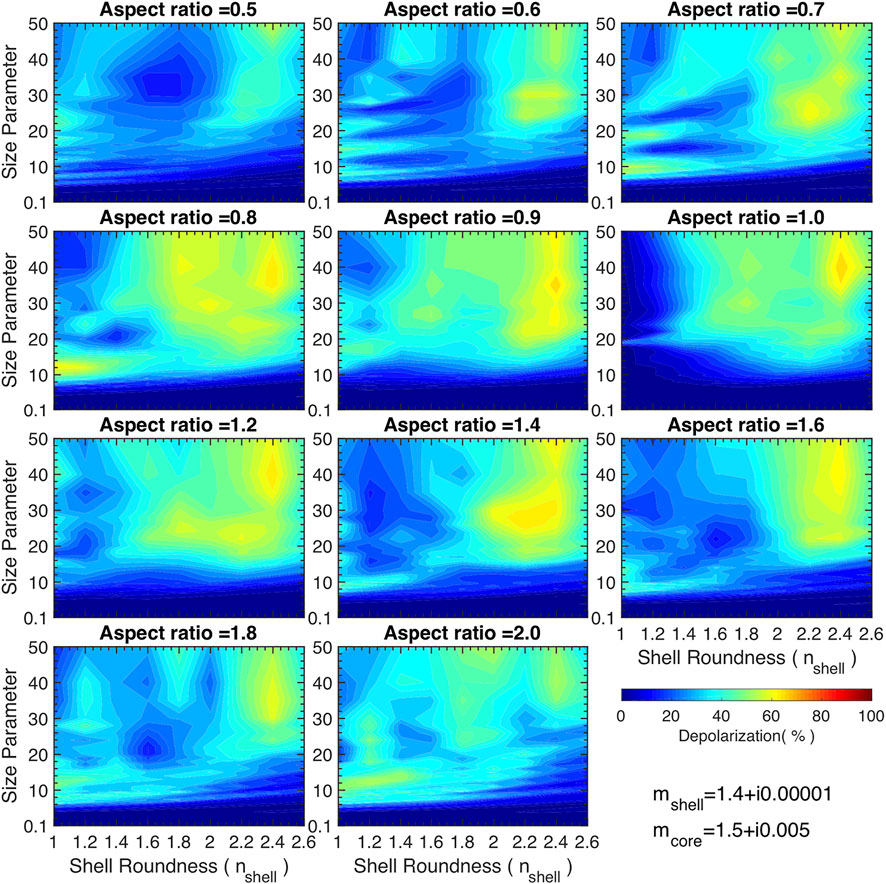
FIGURE 7. Linear depolarization ratios of coated super-spheroids with 11 aspect ratios (0.5–2.0) and nine shell roundness parameters (from 1.0 to 2.6). The core roundness is fixed at 2.6. The size parameter ranges from 0.1 to 50. The refractive indices of the core and shell are 1.5 + i0.005 and 1.4 + i0.00001, respectively.
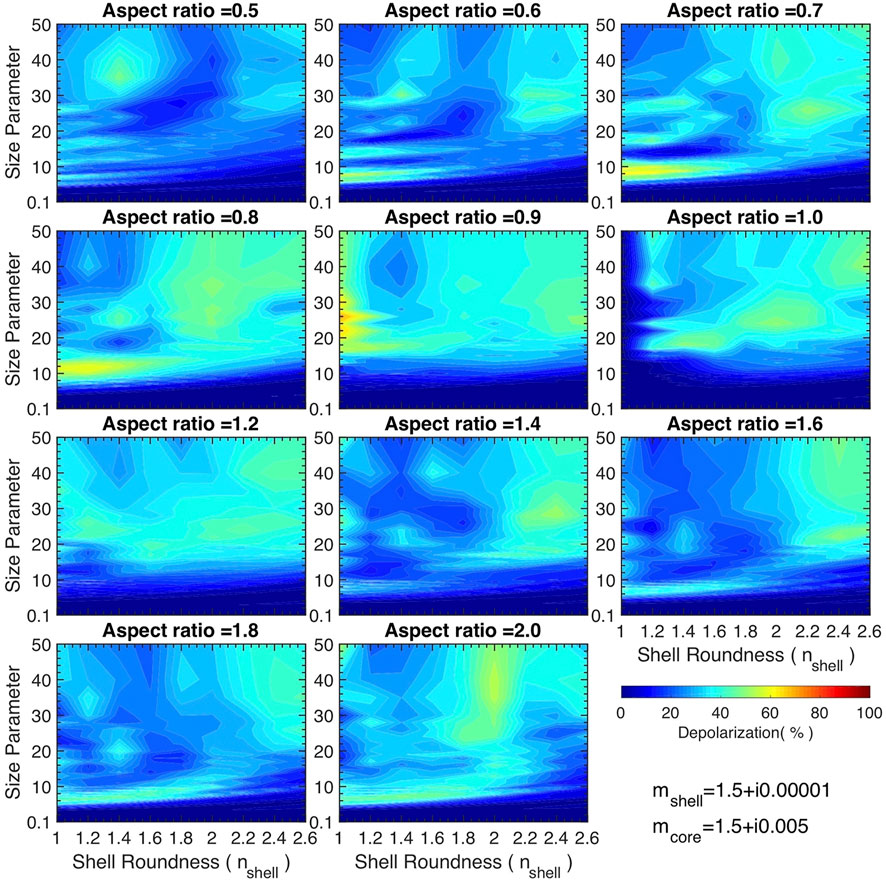
FIGURE 8. Linear depolarization ratios of coated super-spheroids with 11 aspect ratios (0.5–2.0) and nine shell roundness parameters (from 1.0 to 2.6). The core roundness is fixed at 2.6. The size parameter ranges from 0.1 to 50. The refractive indices of the core and shell are 1.5 + i0.005 and 1.5 + i0.00001, respectively.
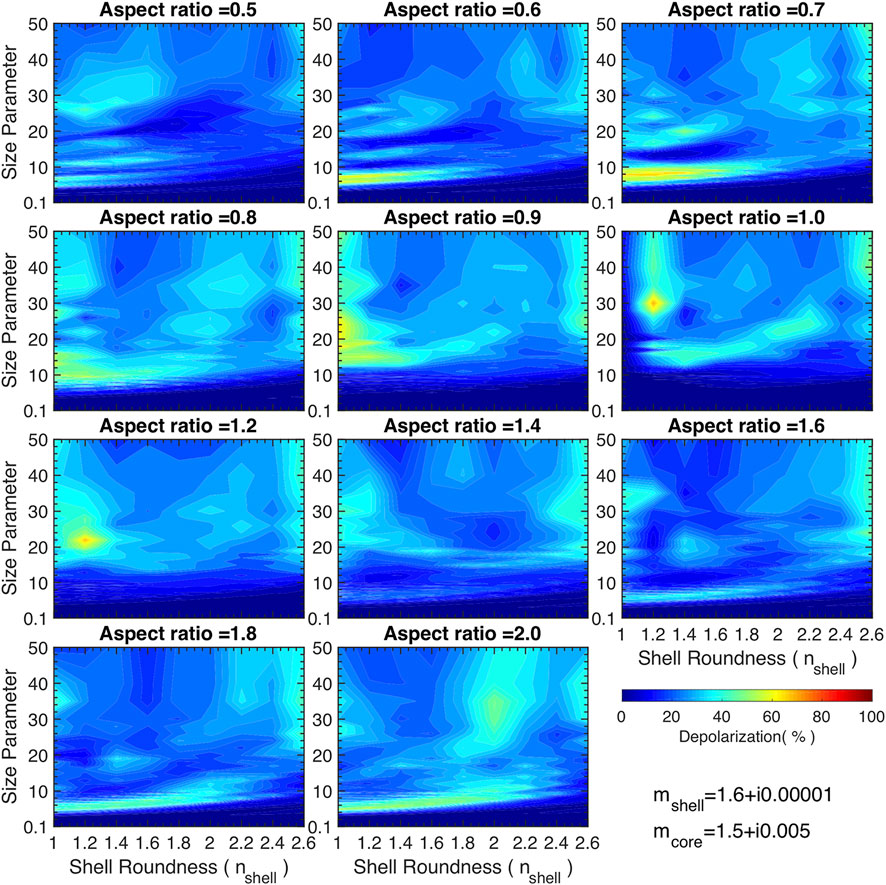
FIGURE 9. Linear depolarization ratios of coated super-spheroids with 11 aspect ratios (0.5–2.0) and nine shell roundness parameters (from 1.0 to 2.6). The core roundness is fixed at 2.6. The size parameter ranges from 0.1 to 50. The refractive indices of the core and shell are 1.5 + i0.005 and 1.6 + i0.00001, respectively.
Nearly spherical particles are nonspherical particles of which both the aspect ratios and roundness parameters are close to unity. For these particles, the LDRs could be enhanced, which can be clearly seen in the cases (aspect ratio = 0.9 and the roundness parameters close to unity) shown in Figures 6–9. Mishchenko and Hovenier (1995) first discovered the remarkable phenomenon of LDRs peaking at aspect ratios of spheroids very close to unity at a refractive index close to 1.5. For homogeneous spheroids and super-spheroids, higher LDRs for nearly spherical particles were closely examined by resolving the refractive index variation in previous studies by using a Debye series technique (Bi et al., 2018a; 2018b). It was found that higher LDRs (>∼60%) are common for optically soft particles (the real part of the complex refractive index is smaller than ∼1.2). However, for larger real parts of the complex refractive indices (>1.3), higher LDRs (>∼60%) are almost only observed for nearly spherical particles. This unique phenomenon disappears as the refractive index exceeds 1.7. We note that Gialitaki et al. (2020) recently explored the use of near-spherical-shaped particles to reproduce the triple-wavelength HSRL observations.
To further examine the LDRs of nearly spherical coated super-spheroids, Figure 10 shows the LDRs for inhomogeneous spheroidal particles with aspect ratios of 0.8–1.2 and a fine resolution of 0.01. For the purpose of comparison, the LDRs for homogeneous spheroids are shown in Figure 11. The refractive index of homogeneous spheroids is the same as that of the shell’s refractive index shown in Figure 10. It is evident that the LDRs for inhomogeneous spheroids are smaller than those of homogeneous spheroids when the real part of the shell’s refractive index (1.3, 1.35, and 1.45) is smaller than the core refractive index (1.5). However, enhanced LDRs are still obvious when the real part of the shell’s refractive index (e.g.,
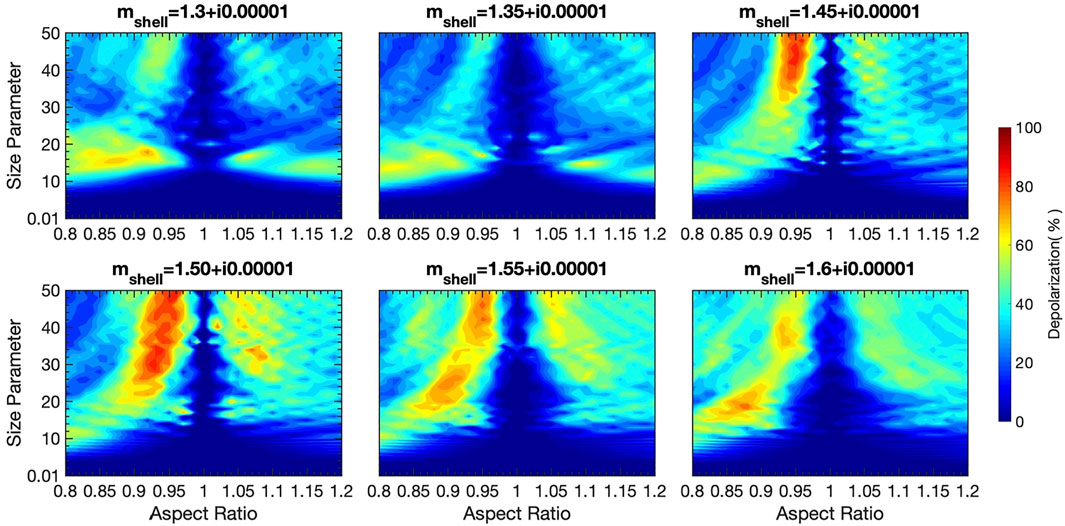
FIGURE 10. Linear depolarization ratios for nearly spherical particles (inhomogeneous spheroids). The core refractive index is 1.5 + i0.005. When the aspect ratio is unity, LDRs are small but not exactly zeros because the core is a non-spherical particle.
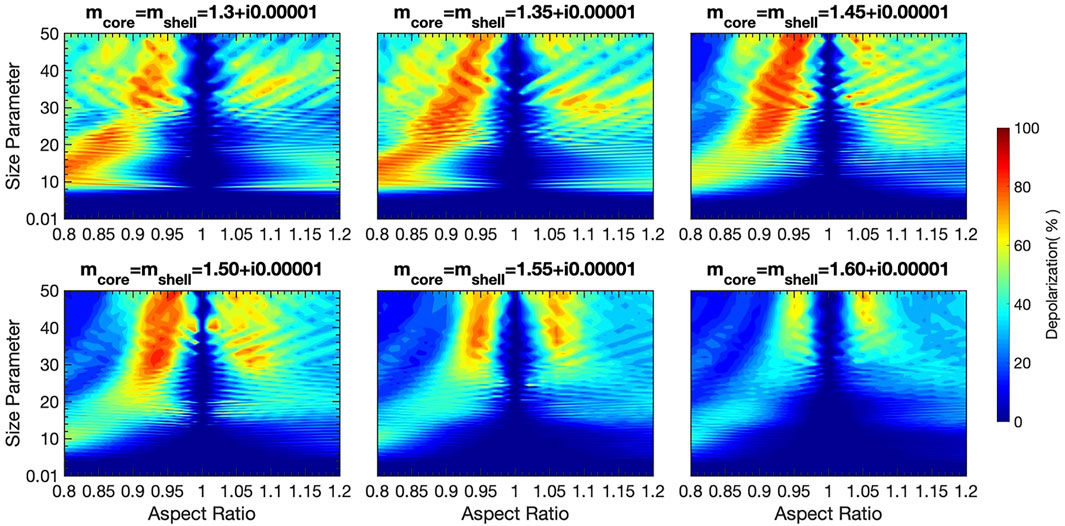
FIGURE 11. Linear depolarization ratios for nearly spherical particles (homogeneous spheroids). Both the shell and core refractive indices are identical.
From the previous results, it is clear that the LDRs of coated super-spheroids are significantly different from those of homogeneous super-spheroids. The most interesting phenomenon could be the higher LDRs for super-spheroids with thin coating. The conditions of a thin coating might be relevant to dust particles in an ambient atmospheric environment when the relative humidity is not high. Previous findings of higher LDRs for nearly spherical homogeneous particles might still be interesting for coated dust particles because nearly spherical coated dust could be common for high relative humilities according to TEM images. The refractive indices of the coating (sulfate, nitrate, and water aerosols) are smaller than the refractive index of dust, which causes lower LDRs in comparison with homogeneous particles with respect to the shell’s refractive index. However, higher LDRs are still observable, particularly when the refractive index of water-soluble aerosols is close to the refractive index of dust.
For particles with a high degree of non-sphericity, the refractive index of the coating shell is critical to the LDRs. The LDRs are generally larger for smaller real parts of the shell’s refractive indices. This feature is quite interesting because the required condition for the refractive index (<∼1.4) is close to real situations. Therefore, we believe that these findings from a purely theoretical simulation might be useful for relevant optical interpretation in lidar observations. Future work could involve a systematic comparison between simulations and lidar observations of dust particles in a polluted region, which could provide interesting and important results.
Conclusion
We have developed a GPU implementation of IITM for computing the optical properties of coated super-spheroids, which was much more efficient than the conventional CPU implementation. The acceleration ratio was from approximately 8–25 depending on the size parameter. Based on the GPU-IITM implementation, the optical properties of coated super-spheroids with extensive shapes, sizes, and refractive indices were obtained, and comparisons of the results of coated super-spheroids with those of homogeneous super-spheroids were carried out. Substantial differences could occur, particularly in the lidar backscattering optical properties.
Higher LDRs were found when dust particles had thin coatings. However, the LDRs decreased as the coating particles became rounder. In addition, the LDRs decreased obviously as the real part of the shell’s refractive index increased from 1.3 to 1.6. Special attention should be given to nearly spherical particles, for which the LDRs could be higher, particularly when the real part of shell’s refractive index is close to or larger than the core refractive index. The higher LDRs found for homogeneous nearly spherical particles in the refractive range of 1.3–1.5 were lower when the particle inhomogeneity was incorporated. These findings are expected to have implications in lidar remote sensing, particularly on hazy days when dust particles are mixed with air pollutants.
In this study, we only focused on analyzing the difference of LDRs caused by the particle shell-structure. The differences in the extinction efficiency, single-scattering albedo, and phase matrix are relevant for improving the radiative transfer simulations in remote sensing and climate modeling. However, the analysis of these factors in applications of atmospheric models is beyond the scope of this study. Readers are referred to a recent publication on the evaluation of an internally mixed scheme in the weather-research and forecasting model (Wang et al., 2022).
Data Availability Statement
The original contributions presented in the study are included in the article/Supplementary Material, further inquiries can be directed to the corresponding author.
Author Contributions
LB: Conceptualization, Methodology, Investigation, Software, Writing; ZW: Methodology, Software, Editorial; WH: Discussion, Editorial, Funding; WL: Discussion, Editorial; XZ: Discussion, Editorial, Funding.
Funding
This research was supported by the NSFC Major Project (42090030) and the National Natural Science Foundation of China (42022038).
Conflict of Interest
The authors declare that the research was conducted in the absence of any commercial or financial relationships that could be construed as a potential conflict of interest.
Publisher’s Note
All claims expressed in this article are solely those of the authors and do not necessarily represent those of their affiliated organizations, or those of the publisher, the editors and the reviewers. Any product that may be evaluated in this article, or claim that may be made by its manufacturer, is not guaranteed or endorsed by the publisher.
Acknowledgments
We acknowledge Ms. Rui Liu at the Training Center of Atmospheric Sciences of Zhejiang University for her help with managing computing resources. A portion of the computations were performed on the National Supercomputer Center in Guangzhou (NSCC-GZ), Tianjin (NSCC-TJ), and Wuxi (NSCC-WX) and the cluster at State Key Lab of CAD&CG at Zhejiang University. We acknowledge the use of cuSOLVER (https://docs.nvidia.com/cuda/cusolver/index.html) and cuBLAS (https://docs.nvidia.com/cuda/cublas/index.html) libraries.
References
Barr, A. H. (1981). Superquadrics and Angle-Preserving Transformations. IEEE Comp. Graphics Appl. 1 (01), 11–23. doi:10.1109/mcg.1981.1673799
Bauer, S. E., Mishchenko, M. I., Lacis, A. A., Zhang, S., Perlwitz, J., and Metzger, S. M. (2007). Do sulfate and Nitrate Coatings on mineral Dust Have Important Effects on Radiative Properties and Climate Modeling? J. Geophys. Res. 112, D06307. doi:10.1029/2005jd006977
Bi, L., Lin, W., Liu, D., and Zhang, K. (2018a). Assessing the Depolarization Capabilities of Nonspherical Particles in a Super-ellipsoidal Shape Space. Opt. Express 26 (2), 1726–1741. doi:10.1364/oe.26.001726
Bi, L., Lin, W., Wang, Z., Tang, X., Zhang, X., and Yi, B. (2018b). Optical Modeling of Sea Salt Aerosols: The Effects of Nonsphericity and Inhomogeneity. J. Geophys. Res. Atmos. 123, 543–558. doi:10.1002/2017jd027869
Bi, L., and Yang, P. (2014). Accurate Simulation of the Optical Properties of Atmospheric Ice Crystals with the Invariant Imbedding T-Matrix Method. J. Quantitative Spectrosc. Radiative Transfer 138, 17–35. doi:10.1016/j.jqsrt.2014.01.013
Bi, L., Yang, P., Kattawar, G. W., and Mishchenko, M. I. (2013b). A Numerical Combination of Extended Boundary Condition Method and Invariant Imbedding Method Applied to Light Scattering by Large Spheroids and Cylinders. J. Quantitative Spectrosc. Radiative Transfer 123, 17–22. doi:10.1016/j.jqsrt.2012.11.033
Bi, L., Yang, P., Kattawar, G. W., and Mishchenko, M. I. (2013a). Efficient Implementation of the Invariant Imbedding T-Matrix Method and the Separation of Variables Method Applied to Large Nonspherical Inhomogeneous Particles. J. Quantitative Spectrosc. Radiative Transfer 116, 169–183. doi:10.1016/j.jqsrt.2012.11.014
Chen, S.-L., Chang, S.-W., Chen, Y.-J., and Chen, H.-L. (2021). Possible Warming Effect of fine Particulate Matter in the Atmosphere. Commun. Earth Environ. 2, 208. doi:10.1038/s43247-021-00278-5
Di Biagio, C., Formenti, P., Balkanski, Y., Caponi, L., Cazaunau, M., Pangui, E., et al. (2019). Complex Refractive Indices and Single-Scattering Albedo of Global Dust Aerosols in the Shortwave Spectrum and Relationship to Size and Iron Content. Atmos. Chem. Phys. 19, 15503–15531. doi:10.5194/acp-19-15503-2019
Draine, B. T. (1988). The Discrete-Dipole Approximation and its Application to Interstellar Graphite Grains. ApJ 333, 848–872. doi:10.1086/166795
Dubovik, O., Li, Z., Mishchenko, M. I., Tanré, D., Karol, Y., Bojkov, B., et al. (2019). Polarimetric Remote Sensing of Atmospheric Aerosols: Instruments, Methodologies, Results, and Perspectives. J. Quantitative Spectrosc. Radiative Transfer 224, 474–511. doi:10.1016/j.jqsrt.2018.11.024
Dubovik, O., Sinyuk, A., Lapyonok, T., Holben, B. N., Mishchenko, M., Yang, P., et al. (2006). Application of Spheroid Models to Account for Aerosol Particle Nonsphericity in Remote Sensing of Desert Dust. J. Geophys. Res. 111, D11208. doi:10.1029/2005jd006619
Egel, A., Pattelli, L., Mazzamuto, G., Wiersma, D. S., and Lemmer, U. (2017). CELES: CUDA-Accelerated Simulation of Electromagnetic Scattering by Large Ensembles of Spheres. J. Quantitative Spectrosc. Radiative Transfer 199, 103–110. doi:10.1016/j.jqsrt.2017.05.010
Gialitaki, A., Tsekeri, A., Amiridis, V., Ceolato, R., Paulien, L., Kampouri, A., et al. (2020). Is the Near-Spherical Shape the "new Black" for Smoke? Atmos. Chem. Phys. 20, 14005–14021. doi:10.5194/acp-20-14005-2020
Huntemann, M., Heygster, G., and Hong, G. (2011). Discrete Dipole Approximation Simulations on GPUs Using OpenCL-Application on Cloud Ice Particles. J. Comput. Sci. 2 (3), 262–271. doi:10.1016/j.jocs.2011.05.011
Iadarola, G., Forestiere, C., Dal Negro, L., Villone, F., and Miano, G. (2012). GPU-accelerated T-Matrix Algorithm for Light-Scattering Simulations. J. Comput. Phys. 231 (17), 5640–5652. doi:10.1016/j.jcp.2012.03.008
Kahnert, M., Nousiainen, T., and Lindqvist, H. (2014). Review: Model Particles in Atmospheric Optics. J. Quantitative Spectrosc. Radiative Transfer 146, 41–58. doi:10.1016/j.jqsrt.2014.02.014
Kong, S., Sato, K., and Bi, L. (2022). Lidar Ratio-Depolarization Ratio Relations of Atmospheric Dust Aerosols: The Super‐Spheroid Model and High Spectral Resolution Lidar Observations. JGR Atmospheres 127, e2021JD035629. doi:10.1029/2021JD035629
Li, M., Bi, L., Lin, W., Weng, F., He, S., and Zhang, X. (2022). The Inhomogeneity Effect of Sea Salt Aerosols on the TOA Polarized Radiance at the Scattering Angles Ranging from 170° to 175°. IEEE Trans. Geosci. Remote Sensing 60 (1–12), 4102912. doi:10.1109/tgrs.2021.3099026
Li, W. J., and Shao, L. Y. (2009). Observation of Nitrate Coatings on Atmospheric Mineral Dust Particles. Atmos. Chem. Phys. 9 (6), 1863–1871. doi:10.5194/acp-9-1863-2009
Lin, W., Bi, L., and Dubovik, O. (2018). Assessing Superspheroids in Modeling the Scattering Matrices of Dust Aerosols. J. Geophys. Res. Atmospheres 123, 13917–13943. doi:10.1029/2018jd029464
Lin, W., Bi, L., Weng, F., Li, Z., and Dubovik, O. (2021). Capability of Superspheroids for Modeling PARASOL Observations under Dusty‐Sky Conditions. J. Geophys. Res. Atmos. 126 (1), e2020JD033310. doi:10.1029/2020jd033310
Liu, C., Lee Panetta, R., and Yang, P. (2012). Application of the Pseudo-spectral Time Domain Method to Compute Particle Single-Scattering Properties for Size Parameters up to 200. J. Quantitative Spectrosc. Radiative Transfer 113, 1728–1740. doi:10.1016/j.jqsrt.2012.04.021
Liu, L., Schuster, G. L., Moosmüller, H., Stamnes, S., Cairns, B., and Chowdhary, J. (2022). Optical Properties of Morphologically Complex Black Carbon Aerosols: Effects of Coatings. J. Quantitative Spectrosc. Radiative Transfer 281, 108080. doi:10.1016/j.jqsrt.2022.108080
Mackowski, D. W., and Mishchenko, M. I. (1996). Calculation of the T Matrix and the Scattering Matrix for Ensembles of Spheres. J. Opt. Soc. Am. A. 13, 2266–2278. doi:10.1364/josaa.13.002266
Mishchenko, M. I., Travis, L. D., and Lacis, A. A. (2002). Scattering, Absorption and Emission of Light by Small Particles. Cambridge: Cambridge University Press.
Mishchenko, M. I., Dlugach, J. M., and Liu, L. (2016). Linear Depolarization of Lidar Returns by Aged Smoke Particles. Appl. Opt. 55, 9968–9973. doi:10.1364/ao.55.009968
Mishchenko, M. I., and Hovenier, J. W. (1995). Depolarization of Light Backscattered by Randomly Oriented Nonspherical Particles. Opt. Lett. 20 (12), 1356–1358. doi:10.1364/OL.20.001356
Mishchenko, M. I., Liu, L., Travis, L. D., and Lacis, A. A. (2004). Scattering and Radiative Properties of Semi-external versus External Mixtures of Different Aerosol Types. J. Quantitative Spectrosc. Radiative Transfer 88, 139–147. doi:10.1016/j.jqsrt.2003.12.032
Muñoz, O., Moreno, F., Guirado, D., Dabrowska, D. D., Bolten, H., and Hovenier, J. W. (2012). The Amsterdam-Granada Light Scattering Database. J. Quantitative Spectrosc. Radiative Transfer 113 (7), 565–574.
Purcell, E. M., and Pennypacker, C. R. (1973). Scattering and Absorption of Light by Nonspherical Dielectric Grains. ApJ 186, 705–714. doi:10.1086/152538
Sun, L.-H., Bi, L., and Yi, B. (2021). The Use of Superspheroids as Surrogates for Modeling Electromagnetic Wave Scattering by Ice Crystals. Remote Sensing 13 (9), 1733. doi:10.3390/rs13091733
Tang, X., Bi, L., Lin, W., Liu, D., Zhang, K., and Li, W. (2019). Backscattering Ratios of Soot-Contaminated Dusts at Triple LiDAR Wavelengths: T-Matrix Results. Opt. Express 27 (4), A92–A116. doi:10.1364/OE.27.000A92
Tomasi, C., Fuzzi, S., and Kokhanovsky, A. (2017). Atmospheric Aerosols: Life Cycles and Effects on Air Quality and Climate. Weinheim, Germany: Wiley, 708.
Unga, F., Choël, M., Derimian, Y., Deboudt, K., Dubovik, O., and Goloub, P. (2018). Microscopic Observations of Core-Shell Particle Structure and Implications for Atmospheric Aerosol Remote Sensing. J. Geophys. Res. Atmospheres 123, 13944–13962. doi:10.1029/2018jd028602
Wang, H., Shi, G. Y., Zhang, X. Y., Gong, S. L., Tan, S. C., Chen, B., et al. (2015). Mesoscale Modelling Study of the Interactions between Aerosols and PBL Meteorology during a Haze Episode in China Jing-Jin-Ji and its Near Surrounding Region - Part 2: Aerosols' Radiative Feedback Effects. Atmos. Chem. Phys. 15, 3277–3287. doi:10.5194/acp-15-3277-2015
Wang, W., Shao, L., Mazzoleni, C., Li, Y., Kotthaus, S., Grimmond, S., et al. (2021). Measurement Report: Comparison of Wintertime Individual Particles at Ground Level and above the Mixed Layer in Urban Beijing. Atmos. Chem. Phys. 21, 5301–5314. doi:10.5194/acp-21-5301-2021
Wang, Z., Bi, L., Wang, H., Wang, Y., Han, W., and Zhang, X. (2022). Evaluation of a New Internally-Mixed Aerosol Optics Scheme in the Weather Research and Forecasting Model. J. Quantitative Spectrosc. Radiative Transfer 283, 108147. doi:10.1016/j.jqsrt.2022.108147
Xu, F., Gao, L., Redemann, J., Flynn, C. J., Espinosa, W. R., da Silva, A. M., et al. (2021). A Combined Lidar-Polarimeter Inversion Approach for Aerosol Remote Sensing over Ocean. Front. Remote Sens. 2, 620871. doi:10.3389/frsen.2021.620871
Yang, P., Hioki, S. S., Saito, M., Kuo, C.-P., Baum, B., and Liou, K.-N. (2018). A Review of Ice Cloud Optical Property Models for Passive Satellite Remote Sensing. Atmosphere 9, 499. doi:10.3390/atmos9120499
Yang, P., and Liou, K. N. (1996). Finite-difference Time Domain Method for Light Scattering by Small Ice Crystals in Three-Dimensional Space. J. Opt. Soc. Am. A. 13, 2072–2085. doi:10.1364/josaa.13.002072
Yurkin, M. A., and Hoekstra, A. G. (2007). The Discrete Dipole Approximation: an Overview and Recent Developments. J. Quantitative Spectrosc. Radiative Transfer 106, 558–589. doi:10.1016/j.jqsrt.2007.01.034
Zhang, X., Duan, J., Dai, C., and Wei, H. (2020). Linear Depolarization Ratios of Nitrate-Coated mineral Dust Particles in Haze Episodes. Appl. Opt. 59, 2057–2064. doi:10.1364/ao.385225
Zhang, X., Wei, H., Zou, S., Duan, J., Li, W., and Dai, C. (2022). Effect of Nitrate Coatings on the Optical Properties of mineral Dust Particles during the Haze Aging Process. J. Quantitative Spectrosc. Radiative Transfer 277, 107966. doi:10.1016/j.jqsrt.2021.107966
Keywords: light scattering, super-spheroids, core-shell, T-matrix, GPU 2
Citation: Bi L, Wang Z, Han W, Li W and Zhang X (2022) Computation of Optical Properties of Core-Shell Super-Spheroids Using a GPU Implementation of the Invariant Imbedding T-Matrix Method. Front. Remote Sens. 3:903312. doi: 10.3389/frsen.2022.903312
Received: 24 March 2022; Accepted: 31 March 2022;
Published: 25 April 2022.
Edited by:
Feng Xu, University of Oklahoma, United StatesReviewed by:
Eduard Chemyakin, National Aeronautics and Space Administration (NASA), United StatesPeng-Wang Zhai, University of Maryland, Baltimore County, United States
Copyright © 2022 Bi, Wang, Han, Li and Zhang. This is an open-access article distributed under the terms of the Creative Commons Attribution License (CC BY). The use, distribution or reproduction in other forums is permitted, provided the original author(s) and the copyright owner(s) are credited and that the original publication in this journal is cited, in accordance with accepted academic practice. No use, distribution or reproduction is permitted which does not comply with these terms.
*Correspondence: Lei Bi, bilei@zju.edu.cn
 Lei Bi
Lei Bi Zheng Wang
Zheng Wang Wei Han2
Wei Han2  Weijun Li
Weijun Li